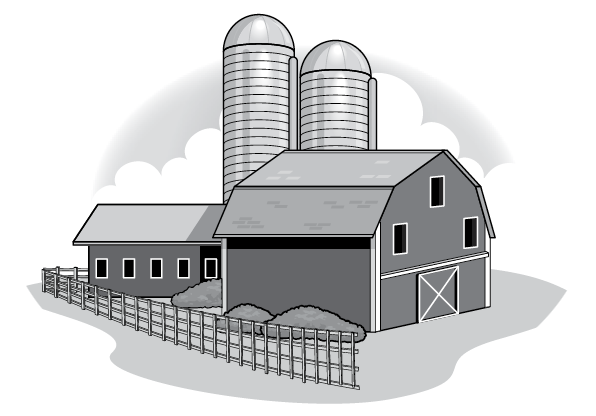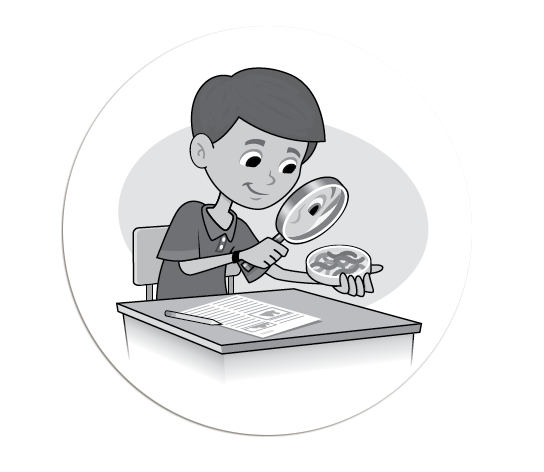Agricultural Literacy Curriculum Matrix
Lesson Plan
Significant Surroundings
Grade Level
Purpose
Students identify basic animal behaviors, hypothesize what causes them, and discover the responsibilities of an animal physiologist. Grades 3-5
Estimated Time
Materials Needed
Background
Activity 1: Observing a Mealworm
- Shoebox with lid, 1 per group
- Flashlight, 1 per group
- Construction Paper, 1 sheet per group
- Sandpaper, 1 piece per group
- Resealable, quart-size plastic bags, 2 per group
- Lightweight paper, 1 sheet per group
- Mealworms, 10 per group (Mealworms can be purchased from a pet or fishing bait store)
- Timer, 1 per group
- Scissors, 1 pair per group
- Hand lens, 1 per group
- Ruler, 1 per group
- Significant Surroundings Lab handout, 1 per student
- All About Mealworms information sheet
Activity 2: Making a Graphic Organizer
- Staplers and masking tape
- Colored construction paper, 3 sheets per student
- Crayons, markers, or colored pencils
Vocabulary
animal physiologist: a career area studying and observing animals in their natural environment
behavior: the way in which an animal acts in response to a particular situation or stimulus
environment: the surroundings or conditions in which a person, animal, or plant lives or operates
livestock: farm animals (such as cows, horses, and pigs) that are kept, raised, and used by people
well-being: the contentment of an animal measured by indicators including behavior, physiology, longevity, and reproduction
Did You Know?
- An animal physiologist conducts research to observe and discover how animals react to factors such as temperature, air quality, disease, diet, and poisons.1
- An animal physiologist may work at a university and teach classes in addition to conducting research.1
- Animal physiologists may also work for a pharmaceutical, feed, or other company.1
Background Agricultural Connections
 This lesson is one in a series of five related lessons to promote the development of STEM abilities and critical thinking skills, while fostering an appreciation for the people involved in livestock production. For more information about what STEM is, why it's important, and how it can be implemented in your classroom, watch the video, What is STEM? The curriculum includes real-life challenges for students to investigate, inquiry-based labs, and opportunities to plan and construct models. Featured careers include:
This lesson is one in a series of five related lessons to promote the development of STEM abilities and critical thinking skills, while fostering an appreciation for the people involved in livestock production. For more information about what STEM is, why it's important, and how it can be implemented in your classroom, watch the video, What is STEM? The curriculum includes real-life challenges for students to investigate, inquiry-based labs, and opportunities to plan and construct models. Featured careers include:
- Animal Physiologist: Significant Surroundings
- Agricultural Engineer: Build it Better
- Animal Geneticist: Roll of the Genes
- Animal Nutritionist: Got Guts?
- Range Manager: Homes on the Range
An animal’s behavior is determined by genetics as well as experiences in its social (other animals of the same species) and physical (where it was raised) environment. These experiences can cause changes in physiology, the nervous system, and physical structures of the body. Animals change throughout their lives based on their experiences. However, experiences early in life often have the greatest effect on animals and can even affect gene expression.
Animal physiologists study how animals function and behave, including how animals interact with the environment outside their body, such as temperature, lighting, or sound in addition to things inside their body, such as disease, poisons, or diet. This knowledge helps animal physiologists recommend the environmental specifications needed for the animal’s well-being, including housing and nutrition. In this lesson, students will explore how animal physiologists study cattle, horses, poultry, and other livestock in the field and conduct a small-scale experiment with mealworms in the classroom.
Mealworms are the larval form of the mealworm beetle, a species of the darkling beetle. They go through four life stages—egg, larva, pupa, and adult.
For more information, see Commonly Asked Questions.
Engage
- Have students brainstorm the senses they use to interact with the world around them. Ask students to close their eyes and use their remaining senses (hearing, taste, touch, and smell) to observe their current environment. Facilitate this interaction by prompting them to notice their surroundings with the following questions:
- What do you feel?
- What do you smell?
- What do you hear?
- Ask students to open their eyes and briefly discuss their observations. Explain that by making observations, they are acting as physiologists. The word “physiologist” comes from the Greek word “physis,” meaning “nature” or “natural” and “ologist,” which means “one who studies.” Animal physiologists make observations, or study, how animals naturally interact within their environment. “Environment” is a term that describes the surroundings or conditions in which a person, animal, or plant lives or operates. An animal’s environment can positively or negatively affect the animal’s well-being. An animal physiologist works to make sure that an animal’s environment includes the ideal temperature, air flow, and shelter they need to be healthy. Remind students that animals can’t explain how they feel, so it is essential that an animal physiologist have excellent observation skills.
- Explain to students that in this lesson, they will:
- identify basic animal behaviors and hypothesize what causes them; and
- discover the responsibilities of an animal physiologist.
Explore and Explain
Activity 1: Observing a Mealworm
- Tell the students that today they are going to be animal physiologists. Their first responsibility is to evaluate the environmental preferences of mealworms (the larval stage of the darkling beetle). To determine these preferences, they will experiment with different temperatures, lighting, and surface textures and observe how the mealworms respond.
 Divide students into small groups and distribute the materials. Instruct students to observe their mealworms using a hand lens and record their findings on the “My Observations” section of the Significant Surroundings Lab handout. If needed, guide observation with the following questions:
Divide students into small groups and distribute the materials. Instruct students to observe their mealworms using a hand lens and record their findings on the “My Observations” section of the Significant Surroundings Lab handout. If needed, guide observation with the following questions:
- How many segments does your mealworm have?
- How many legs does it have?
- Does a mealworm have antennae?
- Can you see the mouthparts?
- How do we know the mealworm is the larval stage of an insect and not a true worm?
- How does the mealworm move?
- In this lab, students will carry out three different experiments to test the environmental preferences of mealworms. Each half of the shoebox will offer the mealworms a different environment to choose. Students will record their findings on the Significant Surroundings Lab handout. Instruct students to complete the lab activities. Assist and clarify as necessary.
- Review the All About Mealworms information sheet with the class.
Activity 2: Making a Graphic Organizer
- Building on the discoveries made in Activity 1, students will choose a livestock animal (an animal raised in an agricultural setting to produce food, fiber, or labor) to research and create a guide for their ideal environmental conditions, which may include:
- Temperature
- Shelter
- Space
- Sound
- Nutrition
- Bedding
- Lighting
- Demonstrate how to create a three-dimensional graphic organizer to record students’ research. This educational tool helps students organize information in a kinesthetic way. Watch the step-by-step video on how to create a three-dimensional graphic organizer.
- Stack three different colored sheets of paper (8 ½" x 11") together, placing each consecutive sheet around ¾ of an inch higher than the sheet in front of it.
- Bring the top of the sheets downward and align the edges so that all of the layers or tabs are the same distance apart.
- When all of the tabs are equal distance apart, fold the papers and crease well.
- Staple the sheets of paper together along the center fold.
- Fold the graphic organizer in half to create a booklet with a front and back cover.
- Instruct students to decorate the cover of their three-dimensional graphic organizer with their name and a picture of their livestock animal. On each tab, students should write the type of environmental condition considered and the preferred condition for their specific animal. Research sources should include books or databases in the library, internet searches (validating sources), and interviews (primary sources) if possible.
Variation
- Use online resources, such as the National Center for Education Statistics “Create a Graph” tool, to make graphs that illustrate how many mealworms prefer each type of environment.
- Set up a station for each experiment. Prepare and provide several shoeboxes at each station. Have students rotate around the room to complete each lab experiment.
- Prepare the shoeboxes for students prior to starting the lesson.
ELL Adaptations
- This lesson incorporates hands-on activities. Kinesthetic learning events provide an excellent learning environment for English language learners.
- Demonstrate how students may set up their experiment prior to student investigations. ELL students will benefit from observing the procedures before they get started.
Elaborate
-
Have students research a variety of careers (e.g., construction worker, engineer, animal nutritionist, and veterinarian) that may rely on the expertise of an animal physiologist. Challenge students to devise a scenario that integrates each career with animal well-being.
-
Plan and build a model of an “ideal environment” for each livestock animal that the students research. Have students think critically to determine the elements that could negatively affect the environment they create.
-
Students research the educational background and skills required to be an animal physiologist.
Evaluate
After conducting these activities review and summarize the following key concepts:
- An animal physiologist observes and studies animals in their natural environment.
- Animal physiologists assist farmers and ranchers in caring for their animals properly to provide for their safety and welfare.
- Farmers and ranchers are concerned with the welfare of their animals which provide meat, milk, and eggs to our food supply.
Acknowledgements
This lesson was funded in 2012 by the United States Department of Agriculture’s National Institute of Food and Agriculture through the Secondary Education, Two-Year Postsecondary Education, and Agriculture in the K-12 Classroom Challenge Grants Program (SPECA). Graphics submitted by California Foundation for Agriculture in the Classroom.
Executive Director: Judy Culbertson
Illustrator: Erik Davison
Layout and Design: Nina Danner
Recommended Companion Resources
Author
Organization
| We welcome your feedback! If you have a question about this lesson or would like to report a broken link, please send us an email at matrixelearning@gmail.com. If you have used this lesson and are willing to share your experience, we will provide you with a coupon code for 10% off your next purchase at AgClassroomStore. |
